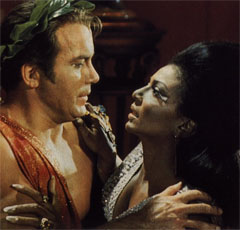|
Intermix.org.uk is a website for the benefit
of mixed-race families, individuals and anyone who feels they have a multiracial
identity and want to join us. Our mission is to offer a view of the mixed-race experience, highlighting icons, film, books, poetry, parenting techniques, celebrities, real lives and much more. Our online forums are a great place to meet others, ask questions, voice your opinions and keep in touch. Sign up for our monthly newsletter and delve into our pages. Want to join in? Become an Intermix member to take part: |
Short-Lived, Oversexed And Downright Dangerous
 Study
highlights Hollywood’s portrayal of mixed-race relationships.
Study
highlights Hollywood’s portrayal of mixed-race relationships.
Despite the large number of mixed-race relationships in the
US, a new study by the University of Florida has found that Hollywood
is still not showing positive portrayals of relationships between men
and women of different races. In fact these relationships are more
likely to be shown as short-lived, oversexed and downright dangerous.
Nadia Ramoutar, a communications professor at Flagler College in St.
Augustine, who did the research her doctoral dissertation in mass communications
at UF goes even further saying:
'A man and a woman of different races in the movies have a greater
statistical probability of dying than of getting married or dating
seriously.'
The study analysed interracial relationships in blockbuster Hollywood
films between 1967 and 2005, beginning with the landmark social commentary
Guess Who’s Coming to Dinner. Nadia selected the 15 top-grossing
box office hits of each year for her sample. Of these, she found 36
films with interracial couples.
Forty-two percent of the women in such partnerships were victims of
violence. 'Lying on the table like a piece of sushi' is
how police described Cheryl, the drug-addicted, sexually deviant female
character in Rising Sun responsible for three men’s
deaths who dies herself.
'The most common racial coupling was a white male with an Asian female,
who was often portrayed as a 'model minority,' in that
she was smarter, more compliant and less sexually aggressive than women
of other races,' says Nadia.
The study also revealed that the majority of black women on the big
screen were usually mixed-race like Halle Berry, with dark-skinned
actresses rarely cast except as villainesses or femme fatales.
White women involved in mixed-race relationships were shown as either
morally corrupt, socially inept or as victims of physical or sexual
abuse, whilst women of colour who became involved with white males
were depicted as exotic, erotic and exceptionally talented.
Also worth noting was the fact that no Arabic or eastern Indian appears
in any of the films and though Asian women were the most common women
of colour representing nearly one-quarter of interracial romances,
Asian men were practically invisible. The only major Asian male in
such a relationship in nearly four decades was Jackie Chan’s
character in the 2001 movie Rush Hour 2.
‘Despite the large number of women actively employed in the American
workplace, the most commonly portrayed occupation of all the women
in these films is that they have no identifiable occupation,’ says
Nadia. 'The second most popular occupation was working as a spy, followed
by a tie between prostitute and entertainer.'
Nadia believes her findings are important. 'Popular films do more than
entertain: They are a powerful means of transmitting culture from one
generation to the next,' says Nadia. 'The results of this study sadly
show that racial and ethnic segregation in romantic relationships is
heavily practiced in Hollywood blockbuster films and has become more
common rather than less common in the past four decades.'
Mmm could that be why Angelina Jolie got the part of Mariane Pearl,
the widow of murdered US journalist Daniel Pearl, in A
Mighty Heart?
Did You Know
The first interracial kiss on British television was in Emergency
Ward 10 in 1964.
In the US it was in Star Trek between James T. Kirk (William Shatner)
and Lt. Uhura (Nichelle Nichols). However, according to William Shatner
and Nichelle Nichols in Shatner's 'Star Trek: Memories',
NBC insisted that their lips never touch. Their heads turn away from
the camera in the shot.
In the UK, the BBC skipped this episode in all runs of the series,
due to the controversial kiss between Kirk and Uhura. It was finally
shown for the first time on December 22, 1993.
What
do you think of Hollywoods portrayal of mixed-race relationships?
Click here to visit the forums and tell us your views:
View this months news:
Source:
